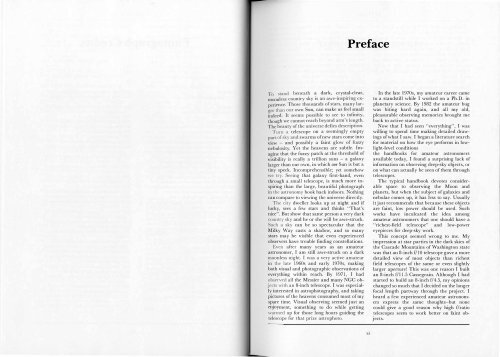OF THE ROGER N. CLARK
OF THE ROGER N. CLARK
OF THE ROGER N. CLARK
Create successful ePaper yourself
Turn your PDF publications into a flip-book with our unique Google optimized e-Paper software.
Preface<br />
To stand beneath a dark, crystal-clear,<br />
moonless country sky is an awe-inspiring experience.<br />
Those thousands of stars, many larger<br />
than our own Sun, can make us feel small<br />
indeed. It seems possible to see to infinity,<br />
though we cannot reach beyond arm's length.<br />
The beauty of the universe defies description.<br />
Turn a telescope on a seemingly empty<br />
part of sky and swarms of new stars come into<br />
view - and possibly a faint glow of fuzzy<br />
nebulosity. Yet the heavens are subtle. Imagine<br />
that the fuzzy patch at the threshold of<br />
visibility is really a trillion suns - a galaxy<br />
larger than our own, in which our Sun is but a<br />
tiny speck. Incomprehensible; yet somehow<br />
we try. Seeing that galaxy first-hand, even<br />
through a small telescope, is much more inspiring<br />
than the large, beautiful photograph<br />
in the astronomy book back indoors. Nothing<br />
can compare to viewing the universe directly.<br />
The city dweller looks up at night and if<br />
lucky, sees a few stars and thinks "That's<br />
nice". But show that same person a very dark<br />
country sky and he or she will be awe-struck.<br />
Such a sky can be so spectacular that the<br />
Milky Way casts a shadow, and so many<br />
stars may be visible that even experienced<br />
observers have trouble finding constellations.<br />
Even after many years as an amateur<br />
astronomer, I am still awe-struck on a dark<br />
moonless night. I was a very active amateur<br />
in the late 1960s and early 1970s, making<br />
both visual and photographic observations of<br />
everything within reach. By 1971, I had<br />
observed all the Messier and many NGC objects<br />
with an 8-inch telescope. I was especially<br />
interested in astrophotography, and taking<br />
pictures of the heavens consumed most of my<br />
spare time. Visual observing seemed just an<br />
enjoyment, something to do while getting<br />
warmed up for those long hours guiding the<br />
telescope for that prize astrophoto.<br />
In the late 1970s, my amateur career came<br />
to a standstill while I worked on a Ph.D. in<br />
planetary science. By 1982 the amateur bug<br />
was biting hard again, and all my oid,<br />
pleasurable observing memories brought me<br />
back to active status.<br />
Now that I had seen "everything", I was<br />
willing to spend time making detailed drawings<br />
of what I saw. I began a literature search<br />
fo r material on how the eye performs in lowlight-level<br />
conditions·<br />
the handbooks for amateur astronomers<br />
available today, I found a surprising lack of<br />
information on observing deep-sky objects, or<br />
on what can actually be seen of them through<br />
telescopes.<br />
The typical handbook devotes considerable<br />
space to observing the Moon and<br />
planets, but when the subject of galaxies and<br />
nebulae comes up, it has less to say. Usually<br />
it just recommends that because these objects<br />
are faint, low power should be used. Such<br />
works have inculcated the idea among<br />
amateur astronomers that one should have a<br />
"richest-field telescope" and low-power<br />
eyepieces fo r deep-sky work.<br />
This concept seemed wrong to me. My<br />
impression at star parties in the dark skies of<br />
the Cascade Mountains of Washington state<br />
was that an 8-inch f/IO telescope gave a more<br />
detailed view of most objects than richest<br />
field telescopes of the same or even slightly<br />
larger aperture! This was one reasorr I built<br />
an 8-inch f/1l.5 Cassegrain. Although I had<br />
started to build an 8-inch f/4.5, my opinions<br />
changed so much that I decided on the longer<br />
focal length partway through the project. I<br />
heard a few experienced amateur astronomers<br />
express the same thoughts-but none<br />
could give a good reason why high f/ratio<br />
telescopes seem to work better on faint objects.<br />
Xl











